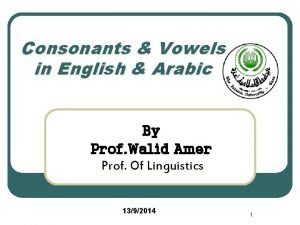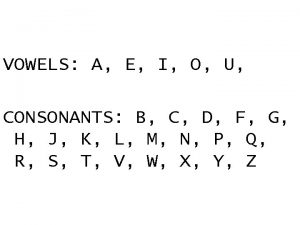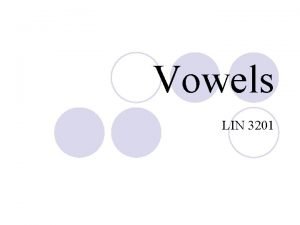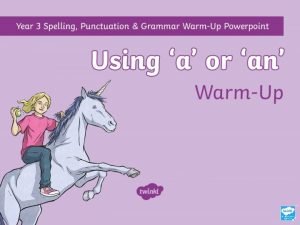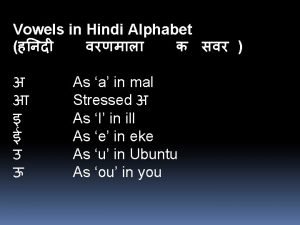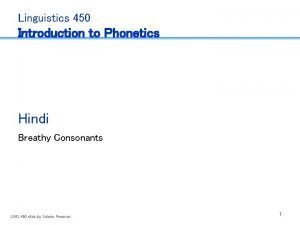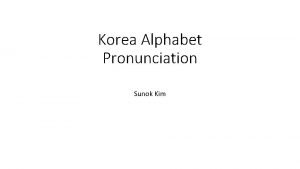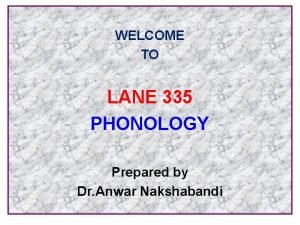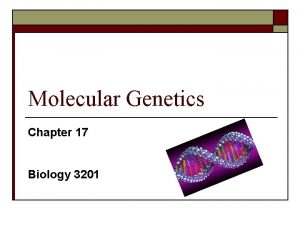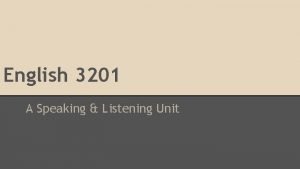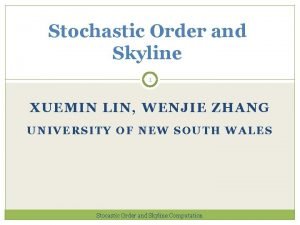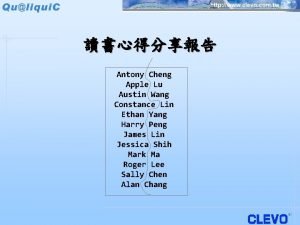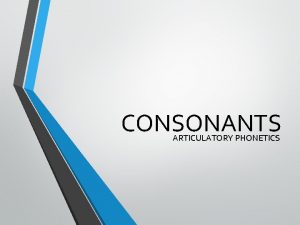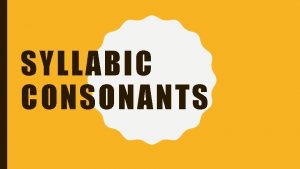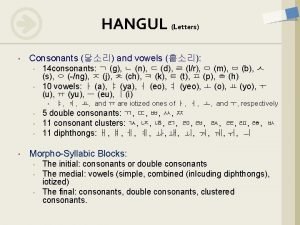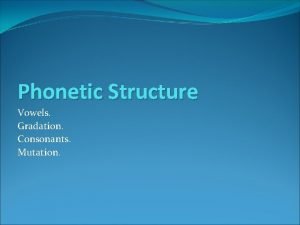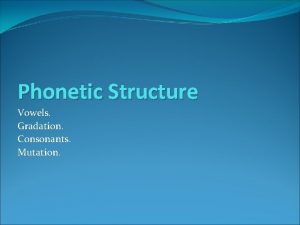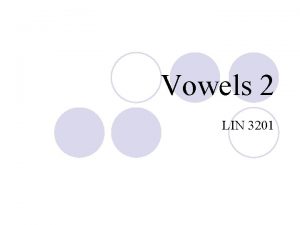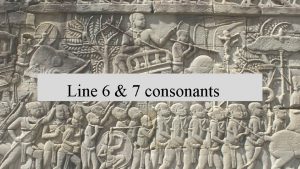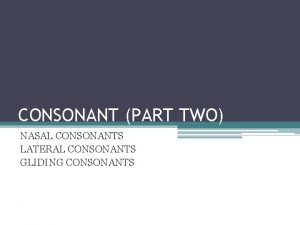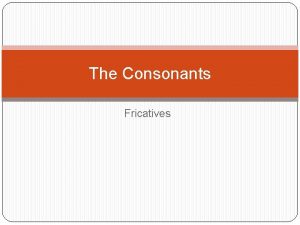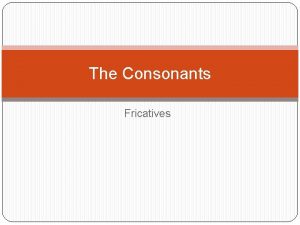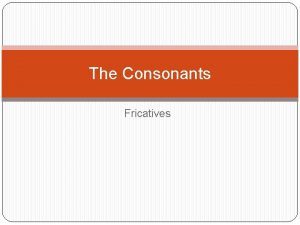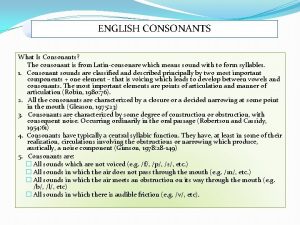Vowels LIN 3201 Vowels vs Consonants Vowels Consonants






![Wait a sec…a semi-vowel? The approximants [j], [w] and [ ] are considered semi-vowels Wait a sec…a semi-vowel? The approximants [j], [w] and [ ] are considered semi-vowels](https://slidetodoc.com/presentation_image/9ab71ce79a263952f4e6a69d0c4bd575/image-7.jpg)






![Lip Rounding Whether lips are rounded or unrounded during vowel production Rounded: [y], [u], Lip Rounding Whether lips are rounded or unrounded during vowel production Rounded: [y], [u],](https://slidetodoc.com/presentation_image/9ab71ce79a263952f4e6a69d0c4bd575/image-14.jpg)
![The front, unrounded vowels 1. 2. 3. 4. 5. 6. [i] close [ ] The front, unrounded vowels 1. 2. 3. 4. 5. 6. [i] close [ ]](https://slidetodoc.com/presentation_image/9ab71ce79a263952f4e6a69d0c4bd575/image-15.jpg)
![The back, rounded vowels [u] close 2. [ ] close/closemid 3. [o] closemid 4. The back, rounded vowels [u] close 2. [ ] close/closemid 3. [o] closemid 4.](https://slidetodoc.com/presentation_image/9ab71ce79a263952f4e6a69d0c4bd575/image-16.jpg)
- Slides: 16

Vowels LIN 3201

Vowels vs. Consonants Vowels Consonants l Pulmonic Egressive Airstream l Many different airstreams – pulmonic glottalic or velaric l Usually voiced, but can be voiceless l Voiced or voiceless l Maintainable articulations l Maintainable and momentary articulations l Less open than [i]; no more open than approximants l Found at edges of syllables, before and after vowels l More open than approximants; all equal to or more open than [i] l Serve as the nucleus of a syllable (carry pitch, tone)

Some caveats about vowels… l Vowels are naturally more difficult than consonants because there are no physical boundaries from one to another l Vowels form a continuum, so some of the delineation of vowels is acoustic and auditory, not articulatory

A caveat for native speakers of American Englishes… Your natural tendency is to GLIDE vowels

What is a GLIDE? l Vowels are produced either as PURE vowels or GLIDED vowels l. A PURE vowel means that throughout the production of the vowel the tongue stays in the same location and maintains the same sound during the entire production of the vowel l i. e. [i], [e], [o], [u]

l. A GLIDED vowel is a slightly longer vowel, in which the tongue moves towards or from production of second vowel during the production l GLIDES are combinations of vowels with semi-vowels [j], [w] or [ ] l i. e. [uw], [oj]
![Wait a seca semivowel The approximants j w and are considered semivowels Wait a sec…a semi-vowel? The approximants [j], [w] and [ ] are considered semi-vowels](https://slidetodoc.com/presentation_image/9ab71ce79a263952f4e6a69d0c4bd575/image-7.jpg)
Wait a sec…a semi-vowel? The approximants [j], [w] and [ ] are considered semi-vowels although they share many characteristics with vowels, they can not serve as syllable nuclei (the center of the syllable) Considered “non-syllabic” versions of [i], [u] and [y] They combine with vowel as vowel glides

l GLIDES may be considered: ² ON-GLIDES Ø glide occurs in syllable initial position Ø Articulates as rapid glide movement from high vowel position [j], central vowel position[ ], low vowel position [w] or retroflex [ ] to following vowel Ø Examples: [jo], [wa]. [ e] OR ² OFF-GLIDES Ø Glide occurs in syllable final position Ø Rapid gliding movement toward high vowel position [j], central vowel position [ ], low vowel position [w] or retroflex [ [ Ø Examples: [ow], [ay]

So just remember… Be VERY careful to produce PURE vowels when needed

4 Parameters for Vowels 1. Tongue Height (high, mid, low) (close, close-mid, open in IPA) 2. Tongue Backness (front, central, back) 3. Tongue Tenseness (tense or lax) 4. Lip Rounding (rounded or unrounded)


Tongue Height Location, or vertical placement of tongue in the mouth High, High-Mid, Low-Mid, Low [IPA: Close, Close-Mid, Open] High: [i], [y], [ ], [u] Mid (Mid-High/Mid-Low): [e], [o], [ ] Low: [a], [æ], [ ]

Tongue Backness Location, or horizontal placement, of tongue in the mouth Front, Central, Back Front: [i], [e], [æ], [a] Central: [ ], [ ] Back: [y], [o], [u], [ ]
![Lip Rounding Whether lips are rounded or unrounded during vowel production Rounded y u Lip Rounding Whether lips are rounded or unrounded during vowel production Rounded: [y], [u],](https://slidetodoc.com/presentation_image/9ab71ce79a263952f4e6a69d0c4bd575/image-14.jpg)
Lip Rounding Whether lips are rounded or unrounded during vowel production Rounded: [y], [u], [o] Unrounded: [i], [e], [ ]
![The front unrounded vowels 1 2 3 4 5 6 i close The front, unrounded vowels 1. 2. 3. 4. 5. 6. [i] close [ ]](https://slidetodoc.com/presentation_image/9ab71ce79a263952f4e6a69d0c4bd575/image-15.jpg)
The front, unrounded vowels 1. 2. 3. 4. 5. 6. [i] close [ ] close/closemid [e] close-mid [ ] open-mid [æ] open-openmid [a] open
![The back rounded vowels u close 2 closeclosemid 3 o closemid 4 The back, rounded vowels [u] close 2. [ ] close/closemid 3. [o] closemid 4.](https://slidetodoc.com/presentation_image/9ab71ce79a263952f4e6a69d0c4bd575/image-16.jpg)
The back, rounded vowels [u] close 2. [ ] close/closemid 3. [o] closemid 4. [ ] openmid 1.
 Vowel clusters examples
Vowel clusters examples Aeiou consonant
Aeiou consonant Difference between vowels and consonants
Difference between vowels and consonants Consonant and vowel sort
Consonant and vowel sort Hindi alphabet vowels
Hindi alphabet vowels Hindi consonant chart
Hindi consonant chart Korean letters with pronunciation
Korean letters with pronunciation Hebrew vowels and consonants
Hebrew vowels and consonants High front vowel
High front vowel Biology 3201 textbook
Biology 3201 textbook English 3201
English 3201 Komdat spm
Komdat spm Lax and tense vowels in english
Lax and tense vowels in english Xuemin lin
Xuemin lin Applelu
Applelu Donn lin
Donn lin Filip lin
Filip lin
